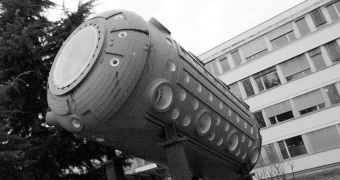A collaboration of physicists at the US Department of Energy's (DOE) Fermi National Accelerator Laboratory (Fermilab), in Batavia, Illinois, say that they have recently managed to establish the energy range of a subatomic particle, called the W boson, with the highest degree of accuracy currently possible.
The new measurements have a dual purpose, since they may also aid the quest for the elusive Higgs boson, the particle hypothesized to exist within the Standard Model. The search for the so-called God Particle is ongoing, and steady progress is being made in Europe and elsewhere.
The Fermilab investigation confirmed that the W boson has a mass of 80.387 gigaelectronvolts (GeV). Together with the Z boson, the two elementary particles form the weak interaction, or weak nuclear force, one of the four fundamental forces of nature, Wired reports.
The weak force is a non-contact force, and is believed to be responsible for critical processes such as nuclear fusion (of the type carried out in the cores of stars) and beta decay-type radioactivity. It affects all fermions (quarks and leptons), but not bosons.
In the past, the most precise measurement of the W boson mass had an uncertainty of 0.060 GeV. While this may seem small at first, the value could make a huge difference at the extremely small scale.
Now, the uncertainty associated with the boson's energy range has been reduced to 0.019 GeV, thanks to the sustained efforts of the Fermilab team. Physicists use energy and mass as interchangeable measures under Albert Einstein's equation E=MC². This shows the two are equivalent.
Details of the research effort were presented in a conference held at Fermilab on February 23, 2012.
The new measurements were derived from data collected by the famous Tevatron particle accelerator, which is now closed. The installation conducted particle physics experiments by colliding protons and antiprotons (their antimatter equivalents) head-on in a 4-mile (6.43-kilometer) circular tunnel.
The capabilities of the Tevatron were utterly surpassed by those of the Large Hadron Collider, which collides protons or ions in a 17-mile (27-kilometer) tunnel. Unlike the Tevatron's 1 TeV maximum output, the LHC is capable of generating a combined collision energy of 14 TeV (teraelectronvolts).
The co-spokesman for the CDF collaboration (the team behind the work), Fermilab physicist Rob Roser, explains that the mass of the W boson is linked to that of the top quark, the heaviest elementary particle, as well as to that of the Higgs boson.
“If you know the mass of any two, you know the mass of the third,” Roser concludes. The new result implies that the Higgs cannot be heavier than 145 GeV, and that LHC results published last year – pinning the elusive boson at 125 GeV – might just be correct.

 14 DAY TRIAL //
14 DAY TRIAL //